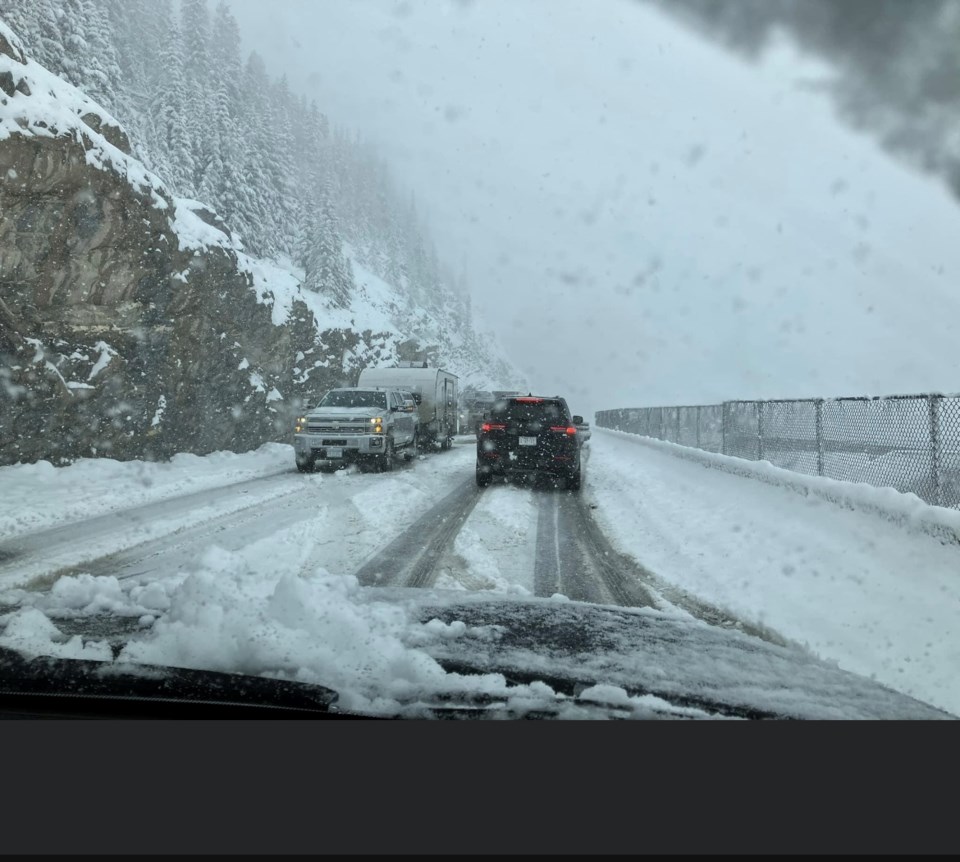BANFF – Hot on the heels of above normal temperatures soaring to the high 20s Celsius, snow dumped at higher elevations in Kananaskis Country and the Bow Valley and forced a rare June snowstorm warning for the Icefields Parkway.
According to Environment Canada, between 20 and 50 centimetres of heavy, wet snow pounded Highway 93 North between Lake Louise and Jasper since Monday (June 19), before tapering off later Tuesday night (June 20).
“Compared to getting all those warm temperatures recently, we had a little bit of a pattern change here,” said Samantha Mauti, a meteorologist with Environment and Climate Change Canada.
“Snow levels are in and around 1,700 metres this morning, and rain through some of the lower terrain areas. It’s also pretty cold and a lot of the temperatures in the area are well below normal for this time of year.”
Mauti said temperatures in Banff and Canmore were well below normal earlier in the week, reaching a high of 13 Celsius on June 18 and a high of 9 C on June 19. Tuesday hit 8 C in Canmore and 7 C in Banff, dropping to 2 C overnight.
“The high for this time of year is normally 19 C, so well below normal temperatures,” said Mauti.
Showers are expected over the coming days.
As the weather system begins to push out, Mauti said temperatures begin to pick up later in the week to a high of 17 C on Thursday, 19 C on Friday, 21 C on Saturday and 19 C on Sunday.
“It will be much closer to normal, but potentially showers,” she said. “Low 20s puts you very close to normal, if not slightly above.”
On Tuesday, Environment and Climate Change Canada presented its seasonal weather outlook for summer, which is expected to bring higher-than-normal temperatures to most of Canada until at least the end of August.
June has already brought above-normal temperatures across the northern prairies, northern Ontario, and northern Quebec. Throughout the summer, higher temperatures are expected to persist in these regions, as well as in the rest of Ontario and Quebec, British Columbia, and Atlantic Canada.
Alberta has been hit hard by early-season wildfires, forcing evacuations of thousands and thousands of residents.
Climate change is causing extreme temperatures at a greater frequency than in the past, increasing the severity of heat waves and contributing to dry conditions, wildfires, and heavy precipitation risks.
More intense rainfalls, which are expected to increase urban flood risks, come with climate change, while coastal flooding is expected to increase in many areas of Canada due to local sea-level rise.
According to Environment and Climate Change Canada, the average intensity of hurricanes is also expected to increase, though an increase in the total number of tropical cyclones is not expected.
“Many parts of the country are already experiencing the devastating impacts of wildfires, driven mainly by higher temperatures and seasonal dryness associated with a warming climate,” according to the June 20 news release.
“In anticipation of a warmer, drier summer and its associated severe conditions, Canadians are urged to regularly monitor weather forecasts, take all weather alerts seriously, and get prepared for weather-related events by developing an emergency plan.”
Climate change is already affecting the frequency, duration, and intensity of extreme weather- and climate-related events in Canada.
“Climate models indicate the country is warming at roughly double the global rate, especially in the north, which will lead to more damaging weather events,” according to the release.
“Canada must keep fighting climate change while preparing for the changes we are already seeing, and adapt to those changes that are here to stay.”




